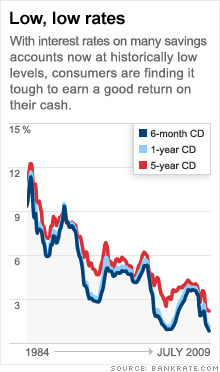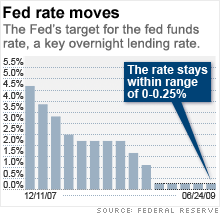Banks offer little love for savers
Thrift is in, but consumers will have to look high and low to earn an attractive rate on their cash if they want to keep their money in a bank.
NEW YORK (CNNMoney.com) -- Americans may be saving more nowadays, but they certainly aren't getting paid for it.
Over the past year, interest rates offered by banks on a wide variety of accounts have steadily declined, only to sink to their lowest levels in years in recent weeks.
A survey by Bankrate.com published this week revealed, for example, that rates on a six-month certificate of deposit stood at 0.77% - the lowest level since the firm started tracking data in January 1984.
Attractive rates are even tough to come by for consumers willing to part with their money for a longer period of time. Depositors putting their money in a 5-year CD earn, on average, a 2.16% annual return on their money.
With deposit rates that low and banks being able to charge much higher interest rates to people looking to borrow money, many banks are generating sizable returns from their lending business.
During the first quarter alone, U.S. banks and thrifts earned $99 billion on loans, an increase of 4.7% compared to the same period a year ago, according to the Federal Deposit Insurance Corp.
"That has been a pleasant reality for a lot of banks," said Curtis Carpenter, managing director of Sheshunoff & Co. Investment Banking.
It was not long ago that banks were trying to lure consumers with some eye-popping deals in what was a fierce battle for deposits.
Back in early 2007, online banks like ING Direct, for example, were offering new customers a 3% yield for its Electric Orange checking account. HSBC Direct, the online banking arm of British bank HSBC, were paying customers a 6% yield on money kept in online savings accounts.
Nowadays, consumers parking their cash in some of those same accounts are fetching just a fraction of what they did two years ago. HSBC's online savings account, for example, currently offers an annual rate of just 1.55%.
Much of that decline was driven by the Federal Reserve's decision to start cutting interest rates in the middle of 2007 in an attempt to keep the U.S. economy afloat. The Fed slashed rates to near zero percent last December and have left them there since then.
But at the same time, banks have had little incentive to raise rates.
Following the drastic plunge in the stock market last fall, consumers have piled into the security of U.S. Treasury bonds and cash in the hopes of merely preserving their savings. Even a paltry 0.5% return in a savings account was much more attractive to some consumers than watching their money fritter away in stocks.
Last year's decision by the Federal Deposit Insurance Corp. to raise its coverage limits to $250,000 per account also offered a greater sense of security for people willing to stash their money in a bank account.
At the same time, banks have been relatively reluctant to make a lot of new loans as the recession drags on, making the need to attract more deposits less urgent, notes Kevin Fitzsimmons, a regional bank analyst at Sandler O'Neill & Partners.
"None of these companies are really growing their balance sheets all that aggressively," Fitzsimmons said. "They do not need deposits so badly."
But it's what the Federal Reserve does with monetary policy in the coming months that will ultimately determine where CD and savings account rates go from here, according to experts.
Fed chairman Ben Bernanke indicated to lawmakers during his semi-annual address to Congress this week that an increase in interest rates was unlikely any time soon. As a result, interest rates on some short-term savings accounts could move even lower.
Greg McBride, a senior financial analyst at Bankrate.com, said that the rates on accounts with shorter maturities are particularly likely to fall further. The rate for a one-year CD is hovering just above its record low rate of 1.04%, which was last reached in July of 2003.
"We are going to get there," McBride said.
At the other end of the spectrum however, there are signs that bankers are already gearing up for an eventual rate hike. This week, the national average for 5-year CDs moved off their lows of 2.15%, according to Bankrate.com's latest survey.
What that ultimately means, said Sheshunoff's Carpenter, is that banks will one day be at it again, trying to poach one another's customers for their deposits.
"As the economy heals and problems in the banking industry go away, competition is going to return," he said.
That day can't come soon enough for savers.
Talkback: Are you frustrated by low rates offered by banks for savings accounts? Share your comments below. ![]()



